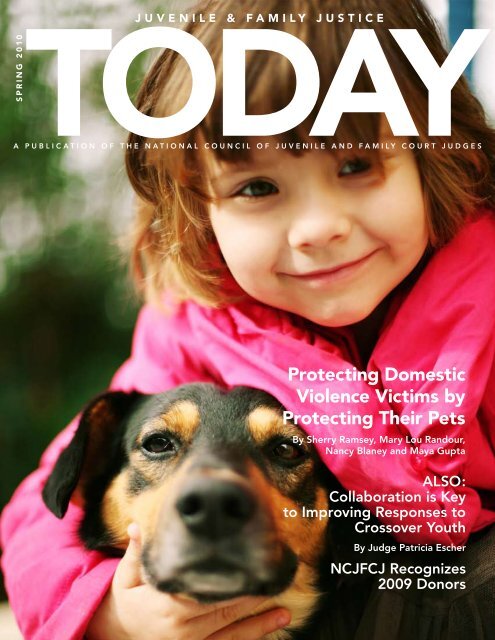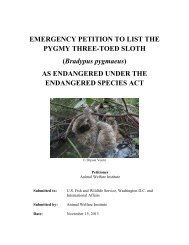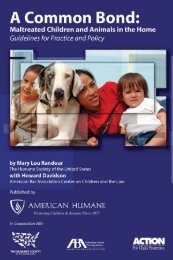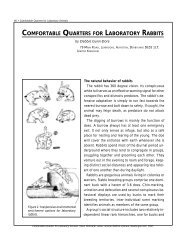Protecting Domestic Violence Victims by Protecting Their Pets
Protecting Domestic Violence Victims by Protecting Their Pets
Protecting Domestic Violence Victims by Protecting Their Pets
- No tags were found...
You also want an ePaper? Increase the reach of your titles
YUMPU automatically turns print PDFs into web optimized ePapers that Google loves.
<strong>Protecting</strong> <strong>Domestic</strong> <strong>Violence</strong><strong>Victims</strong> <strong>by</strong> <strong>Protecting</strong> <strong>Their</strong> <strong>Pets</strong>Put yourself in Betty’s shoes: She knows that she and herchildren are in real danger from the increasingly violentbehavior of her partner, Rick. She has tried a number ofstrategies and knows that she must leave soon with her children. Bettyhas information about the local domestic violence shelter, but there is aproblem, or rather, two problems—the family’s two beloved mutts, Sally andRalph. Sally and Ralph have been the one constant in her children’s lives; theirattachment is not only strong but also a source of comfort and stability to thechildren. Rick has already threatened the dogs, and even lashed out at Ralph withquick kicks to his ribcage. Betty and her children will be protected physically if theyleave, but unless they find a way to place their family pets in a safe situation, they will suffereven greater emotional anguish.Betty’s story is not unusual. Studies show that up to 48% of domestic violence victims reportthat they delayed leaving a dangerous situation because they feared for their pets’ safety andknew of no place to take them (Carlisle-Frank, Frank, & Nielsen 2004). This inability to leave placeswomen, children, and pets at greater risk of exposure to emotional and physical trauma, and death.16 JUVENILE AND FAMILY JUSTICE TODAY | SPRING 2010By Sherry Ramsey, Mary Lou Randour, Nancy Blaney, and Maya Gupta
“<strong>Victims</strong> of family violence are often left in a position ofdeciding whether to stay in an abusive and often dangeroussituation, or to go but leave behind their beloved pets.”<strong>Pets</strong>: Overlooked <strong>Victims</strong> of Family <strong>Violence</strong>As America witnessed during the tragedy of Hurricane Katrina,many people will not leave their homes without their beloved petseven when their own lives are at stake.So it is in domestic violence situations, and abusers know this:The threat, or actual use, of violence against family pets is part ofthe dynamic of family violence—a dynamic that includes not onlythe spouse and batterer, but also the children, elderly relatives, andthe family pet(s).These crimes are often violent and egregious acts of cruelty. Oneof this article’s authors has prosecuted a number of domestic abusecases that included violence against pets, such as setting pets on fire,throwing them off balconies, and beating or killing them in frontof children. <strong>Victims</strong> of family violence are often left in a positionof deciding whether to stay in an abusive and often dangeroussituation, or to go but leave behind their beloved pets. <strong>Victims</strong>know that leaving them behind puts their pets at even greater riskof abuse once the victim is gone. Animals are often used <strong>by</strong> theabuser to punish or manipulate, as well as to take revenge against,the victim. Considering that more than 64 million households inthe United States include one or more companion animals, beingcruel to animals is a common way to punish and control a victimof domestic violence. (Randour & Davidson, 2008). Likewise,attachments to pets on the parts of both victim and the children ina violent family are considerable, and traumatic suffering can resultwhen pets are abused or killed.In the past twenty years, a growing body of research has firmlyestablished a significant link between domestic violence, childabuse, and animal abuse.• Multiple studies have found that as many as 71% of batteredwomen reported that their pets had been threatened, harmed,and or killed <strong>by</strong> their partners (Ascione, Weber, & Wood, 1997;Flynn, 2000; Loring & Bolden-Hines, 2004).• A national survey of battered women’s shelters determined that85% of shelters indicated that women seeking shelter at safehouses talked about incidents of pet abuse (Ascione et al., 1997).• Pet abuse was identified as one of the four significant predictorsfor intimate partner violence in a recent “gold standard”study conducted <strong>by</strong> Dr. Jacquelyn Campbell and colleagues.This study, conducted from 1994 to 2000 in 11 large U.S. cities,used a random sample of 3,737 women, as well as a controlcase sample of 845 women (Walton-Moss, Manganello, Frye, &Campbell, 2005).• Severe physical violence perpetrated <strong>by</strong> the batterer was asignificant predictor of pet abuse (Ascione et al., 2007).• 48% of battered women delay leaving a dangerous situation outof concern for their pet’s safety (Faver & Strand, 2003).• Women have been coerced into committing illegal acts <strong>by</strong> thebatterer because of threats made to their pets (Loring & Bolden-Hines, 2004)• Children exposed to domestic violence are at greater risk of psychologicalmaladjustment, including a higher risk of becomingperpetrators or victims. Pet abuse is an early indicator of suchmaladjustment. Children exposed to domestic violence were atsignificantly increased risk for behavior problems, includinganimal abuse (Baldry, 2003).Household pets are not the only victims; farm animals and horsescan be subject to abuse. One abuse victim noted that when she madeher husband angry, he would beat her beloved horses. These are notisolated cases but rather are typical of how abusers use animals tocontrol victims or seek revenge.Legislatures Respond to the Need to Protect <strong>Pets</strong>After seeing so many people stay behind during HurricaneKatrina to safeguard their pets, many states responded <strong>by</strong>developing emergency plans that include pets to ensure thatpeople will evacuate their homes when called upon to do so. Thefederal government acted as well. In 2006, Congress passed andPresident George W. Bush signed into law the <strong>Pets</strong> Evacuation andTransportation Standards Act. This law requires that local and stateemergency plans cover pets and service animals in order to qualifyfor grants from FEMA. It also provides assistance with creatingappropriate shelters.Similarly, in violent homes throughout the country, domesticviolence victims risk their lives every day staying in dangeroussituations in order to protect a beloved companion animal. As wasthe response to Katrina, it is appropriate that the law and the courtsmake it easier for these victims to protect themselves <strong>by</strong> recognizingthe need to protect their pets.Complicating the issue is the fact that animals are consideredproperty in all 50 states. If an abuser refuses to relinquish a petand the pet is not listed on a temporary restraining order (TRO),police and even courts are often reluctant to get involved in what isusually considered a marital property dispute. As a result, abusershave been known to threaten to harm or kill a pet if a victim doesnot return to the home, or dismiss criminal charges or restrainingorders against an abuser. In one such case, a woman suddenly left adomestic violence shelter after she received pictures of her husbandcutting her dog’s ears off with garden shears. Another woman wasforced to watch as her husband shot and killed her dog in front ofher young son.Existing State Laws Governing Temporary Restraining Ordersthat include <strong>Pets</strong>Many states have recognized that including pets in TROs is animportant component in protecting domestic violence victims.In 2006, Maine enacted the first statute that specifically allowedjudges to include pets in protection orders issued against domesticabusers. New York and Vermont followed suit later that year.Currently, at least 13 states have passed laws to ensure that victimscan include their pets in restraining orders. Numerous other stateshave bills pending or are considering such laws.In addition to these 13 states, some states have passed laws thattake into account animal abuse in domestic violence situations. Forexample, a Florida law provides that the intentional injury or killingof a pet can be one factor used to petition a court for an injunctionfor protection against domestic violence, and also a factorJUVENILE AND FAMILY JUSTICE TODAY | SPRING 2010 17
State Pet Protective Order LawsAugust 2009State Citation Year EnactedCalifornia Family Code § 6320 2007Colorado C.R.S.A § 18-6-803.5 2007Connecticut C.G.S.A § 46b-15 2007Hawaii H.R.S § 586-4 2009Illinois 725 ILCS 5/112A-14 2007Louisiana R.S. 46:2135 2008Maine 19-A MRSA §4007 2006Nevada NRS §§ 33.018 and 33.030 2007New York Family Court Act, § 842 2008North Carolina G.S. § 50B-3 2009Tennessee T.C.A. § 36-3-606 2007Washington RCW §§ 26.50.060 and 26.50.110 2009Vermont 15 V.S.A. § 1103 2006that should be considered in determining whether a petitionerhas reasonable cause to believe he or she is in imminent danger ofbecoming a victim of domestic violence. (Fla. Stat. § 741.30(3)(b) and741.30(6)(b)(4))Indiana law includes animal cruelty, when combined with a crimeagainst a family or household member, as an act of domestic violence.(Burns Ind. Code Ann. § 31-9-2-29.5 (14)) Further, beating, torturing,mutilating, or killing a vertebrate animal with the intent to threaten afamily member is also consideredan act of domestic violence. (Burns“It wasn’t just the cats and dogs, it was theInd. Code Ann. § 31-9-2-42 (4))In Pennsylvania, the law findsthat killing or threatening to killa pet constitutes abuse that canconstitute grounds for grantinga temporary order that requiresthe defendant to relinquish allfirearms to the sheriff. (23 Pa.C.S. §6107 (b)(3)(ii)(E)(II))Although neither Pennsylvania,Indiana, nor Florida has specificlaws to allow pets’ inclusion onrestraining orders, their enactmentof the above legislation shows they recognize the implicationsof animal cruelty in domestic violence.Colorado, which does allow pets to be included on TROs, furtherdefines domestic violence as follows:“<strong>Domestic</strong> violence” also includes any other crime against a person, oragainst property, including an animal, or any municipal ordinanceviolation against a person, or against property, including an animal.(C. R. S. A. § 18-6-800.3)Most states that have express provisions that allow for pets to beincluded in TROs have merely added sections to the TRO that allowfor possession and custody of an animal to the victim. A typicalprovision such as Louisiana’s law states:(7) Granting to the petitioner the exclusive care, possession, or control ofany pets belonging to or under the care of the petitioner or minor childrensheep and the chickens. I was terrified for theirwelfare. I knew if I were to leave, he wouldn’thesitate to kill them. He had done it before.”— Susan Walsh, 50, whose testimony before the Maine legislaturewas instrumental in helping to enact the first state lawthat included animals in domestic violence protective order(The New York Times, Apr. 1, 2006).residing in the residence or household of either party, and directing the defendantto refrain from harassing, interfering with, abusing or injuringany pet, without legal justification, known to be owned, possessed, leased,kept, or held <strong>by</strong> either party or a minor child residing in the residence orhousehold of either party. (LSA-R.S. 46:2135)As previously mentioned, at least 13 states have laws that specificallyallow for inclusion of pets in TROs. Some provisions are morespecific and some are more general in nature. For example, Californialaw states:§ 6320. Ex parte order enjoining contact; companion animals(b) On a showing of good cause, the court may include in a protectiveorder a grant to the petitioner of the exclusive care, possession, or control ofany animal owned, possessed, leased, kept, or held <strong>by</strong> either the petitioneror the respondent or a minor child residing in the residence or household ofeither the petitioner or the respondent. The court may order the respondentto stay away from the animal and forbid the respondent from taking,transferring, encumbering, concealing, molesting, attacking, striking,threatening, harming, or otherwise disposing of the animal.Under Connecticut law:The court, in its discretion, may make such orders as it deems appropriatefor the protection of any animal owned or kept <strong>by</strong> the applicant including,but not limited to, an order enjoining the respondent from injuring orthreatening to injure such animal. If an applicant alleges an immediateand present physical danger to the applicant, the court may issue an exparte order granting such relief as it deems appropriate. (CT ST § 46b-15)Likewise in Illinois, the provision under the domestic violenceorder of protection states:(11.5) Protection of animals. Grant the petitioner the exclusive care,custody, or control of any animal owned, possessed, leased, kept, or held<strong>by</strong> either the petitioner or the respondent or a minor child residing inthe residence or household of either the petitioner or the respondent andorder the respondent to stay awayfrom the animal and forbid the respondentfrom taking, transferring,encumbering, concealing, harming,or otherwise disposing of the animal.(IL ST CH 725 § 5/112A-14)Certainly, all of these laws aremeant to protect the victims ofdomestic violence <strong>by</strong> recognizingthat animal abuse is often usedto hurt the victim. They are alsomeant to protect animals in thesedangerous and volatile situations.Therefore, the dispositionof pets can be an importantconsideration for family court judges when considering or grantinga TRO.When There Are No Specific Provisions in the LawAlthough it is preferable for states to enact laws specificallyallowing the inclusion of pets in TROs, it is arguably permissible inthe absence of such provisions. Having the specific provision withinthe TRO allows for the victim to be presented with the option atthe time of the request. However, in lieu of such a provision, moststate TROs contain language that allows for disposition of specificproperty. Further, most states include language that allows for additionalorders left to the court’s discretion. Accordingly, the courtcan also order that the pets be included in the TRO’s protection, asContinued on page 2018 JUVENILE AND FAMILY JUSTICE TODAY | SPRING 2010
Continued from page 18with the temporary care of the children, or possession of homes orvehicles. Thus, in the same way as certain property is given to thevictim pending a final disposition, so can animals be turned overexclusively to a victim pending the Final Restraining Order hearing.Judges have often used such language to include pets in TROs priorto specific provisions in the law that spell out this consideration.In rare cases, concerns have been raised in situations when anindividual has used the system to obtain possession of pets inappropriatelyor out of spite—not unlike what occasionally happensin certain child custody disputes. Although these may be rarecircumstances, the court can ensure that the pets are safe and fairlyawarded <strong>by</strong> ordering that the pets must remain in the custody ofthe petitioner and not be removed or euthanized pending a finaldisposition of the animals. This is comparable to initial SeparationOrders, which can prohibit the parties from moving any familymembers or assets until the final settlement.Including <strong>Pets</strong> in Temporary Restraining OrdersAllowing pets to be included in restraining orders removes oneobstacle that may prevent a victim from leaving an abusive situation.Including pets in an initial TRO is often essential to protecting theanimal as well as ensuring that the victim can leave without fear ofabuse to her animal family member.In addition, including pets on a TRO can authorize law enforcementto assist the victim in retrieving pets left behind at theresidence during flight. Absent this protection, victims may attemptto return to the residence alone to retrieve or care for pets, placingthemselves in danger of encountering the abuser. In a recent situationknown to one author, a victim staying at a domestic violence shelterreturned to the residence each day at a time when she predicted theabuser would be absent—bringing her children with her—to feedthe dogs and allow them to relieve themselves. After a few days, thevictim became too fearful to attempt the journey. Soon thereafter,she left the shelter due to concern about the dogs, which were herchildren’s beloved pets. While this case clearly illustrates a failure ofthe domestic violence shelter to recognize and address the safety risksinherent in the situation, it is also an example of how including thedogs in a TRO (which this victim did not have) might have produceda different outcome.Animal abuse is a recognized indicator of future violence andis a common and violent crime in domestic violence situations.Understanding how to address animal abuse can protect bothanimals and victims of domestic violence. In the same way thatdomestic violence was once thought of as a minor offense, with education,stronger laws, and judicial attention to these issues, includinganimals in TROs can advance the protection of animals as well asprotect victims and children from additional trauma and violence.ABOUT THE AUTHORS:Sherry Ramsey, a licensed attorney in New York and New Jersey, isManager of Animal Cruelty Prosecutions at the Humane Society ofthe United States.Dr. Mary Lou Randour, Director of Professional Outreach forthe Humane Society of the United States, is a psychologist who hasfocused on research, policy, and practice related to the link betweenanimal cruelty and other crimes, especially interpersonal violence.Nancy Blaney is Senior Policy Analyst at the Animal WelfareInstitute. She has over 25 years of experience advocating on behalfof animals at the state and federal level.Dr. Maya Gupta, a psychologist with interests in the link betweenanimal cruelty and interpersonal violence, is President and CEO ofAhimsa House.ReferencesAscione, F. R., Weber, C. V., Thompson, T. M., Heath, J., Maruyama,M., & Hayashi, K. (2007). Battered pets and domestic violence:Animal abuse reported <strong>by</strong> women experiencing intimate violenceand <strong>by</strong> non-abused women. <strong>Violence</strong> Against Women, 12, 354-373.Ascione, F. R., Weber, C. V., & Wood, D. S. (1997). The abuse ofanimals and domestic violence: A national survey of shelters forwomen who are battered. Society and Animals, 5, 205-218.Baldry, A. C. (2003). Animal abuse and exposure to interparentalviolence in Italian youth. Journal of Interpersonal <strong>Violence</strong>, 18, 258-281.Carlisle-Frank, P., Frank, J. M., & Nielsen, L. (2004). Selective batteringof the family pet. Anthrozoös, 17, 26-42.Faver, C. A., & Strand, E. B. (2003). <strong>Domestic</strong> violence and animalcruelty: Untangling the web of abuse. Journal of Social WorkEducation, 39(2), 237-253.Flynn, C. P. (2000). Why family professionals can no longer ignoreviolence toward animals. Family Relations: Interdisciplinary Journal ofApplied Family Studies, 49(1), 87-95.Loring, M. T., & Bolden-Hines, T.A. (2004). Pet abuse <strong>by</strong> batterersas a means of coercing battered women into committing illegalbehavior. Journal of Emotional Abuse, 4, 27-37.Randour, M. L., & Davidson, H. (2008). A common bond: Maltreatedchildren and animals in the home: Guidelines for practice and policy.American Humane Association and The Humane Society of theUnited States, 1-45.Walton-Moss, B. J., Manganello, J., Frye, V., & Campbell, J. C. (2005).Risk factors for intimate partner violence and associated injuryamong urban women. Journal of Community Health, 30(5), 377–389.DOJ interested in animal cruelty crimesThe U.S. Department of Justice sent a strong signal of its interest in the problem of animal cruelty and interpersonal violence whenits Bureau of Justice Assistance (BJA) awarded the Association of Prosecuting Attorneys nearly $500,000 to provide training and otherassistance to prosecutors in handling animal abuse and animal fighting cases.This project provides on-site and webinar training; Web-based resources, including a brief bank; and ongoing technical assistanceand access to expertise to encourage and enhance the vigorous prosecution of these crimes and address their link to domestic abuse,child abuse, and other forms of violence.20 JUVENILE AND FAMILY JUSTICE TODAY | SPRING 2010
















